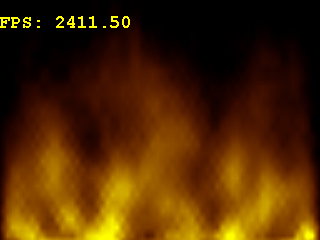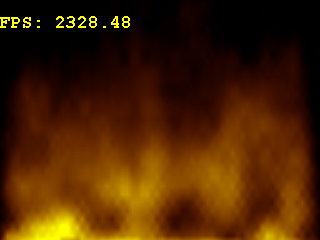GPU Fire


Description:
This project creates an animated fire texture on the GPU. A pbuffer is created, and wglShareLists is used so that the pbuffer and window contexts share textures. A blank texture is also initiated.
The following steps occur:
- Average the values in the texture neighbouring each pixel in the pbuffer, and scroll up by one. This is done in a single pass on the pbuffer, by binding the texture to all four texture units and using NV_register_combiners to take the average.
- Subtract one of four "cooling" textures from the values in the pbuffer, to simulate the flames cooling over time.
- Add fuel values (random 0.0-1.0) to the bottom of the pbuffer.
- Use CopyTexSubImage to copy the pbuffer contents back into the texture.
- Display the texture in the window, using NV_register_combiners to convert the texture's alpha values to realistic colors.
- Repeat from step 1.
Note that all drawing to the pbuffer occurs in the alpha channel only. This is because this technique is adapted from one which used a paletted display. The texture is converted into color values only when it is drawn to the screen.
Requirements:
ARB_multitexture with at least 4 texture units
ARB_texture_border_clamp
EXT_blend_minmax
EXT_blend_subtract
NV_register_combiners with at least 3 general combiners
WGL_ARB_extensions_string
WGL_ARB_pbuffer
WGL_ARB_pixel_format
References:
Dynamic Texturing, by Mark Harris developer.nvidia.com
